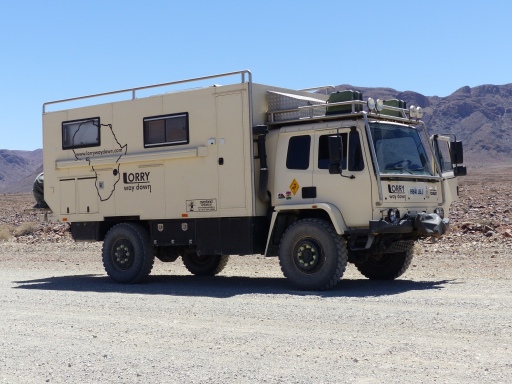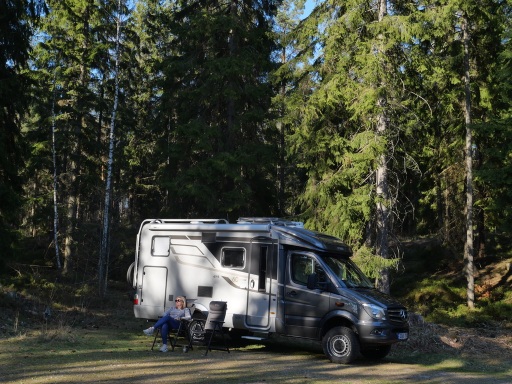As most of you will know up until the end of 2018, we had for the previous 7 years been using/travelling a ex-military Leyland Daf 4×4 truck with a fully loaded weight of nudging 10 tonnes, we are now travelling in a Mercedes Sprinter 4×4 based Hymer built motorhome, with a gross weight of just over 4 tonnes, so whats the difference and what are the pros and cons of each setup?
First of all, Colonel K our trusty Daf overland truck served us unbelievably well, especially on our 3 years travelling the African Continent. It was based on a 1991 vehicle that was designed in the 1980’s, with mechanicals to match. In other words, simple to fix in the field, with zero electronics, just what you need in Africa. Indeed many local “bush mechanics” recognised the engine as soon as they saw the 5.9L Cummins unit. Whilst the truck, engine wise, remained incredibly reliable, (it was very low mileage), the rest of the cycle parts, drive train, hydralics, brakes, electrics, fuel system etc did need constant fettling and maintenance. Not a major problem if your slightly handy with a basic tool kit, but did wear on us a bit at times, after all it was a 25 plus year old vehicle that had been standing around most of its life.

Whilst we both had our HGV licences, Jac was never happy driving Colonel K, the Daf’s are a bit of a beast to drive, and I always felt that Jac was missing out by not driving. With this in mind we hatched a plan to get a smaller vehicle of some kind.
The next question was, what base vehicle do we go with on a new camper? one thing that has always remained constant is our love to explore slightly out of the way places, wild camping plus, if you like. We wanted to maintain the ability to explore down that forest track, or to drive on that beach, or not worry about ground clearance, in other words it must be on a 4×4 chassis with the added clearance that that brings. So if we wanted to stay below 7 tonnes, and reduce the size to something more European friendly, the options at the moment are Mitsubishi Fuso/Canter on a 4×4 6.5 tonne chassis, Iveco Daily 4×4 Chassis cab, or Mercedes Sprinter 4×4. There are other slightly more obscure military based options, but they are not mainstream enough for us. With the Fuso or Iveco we would have to go to a custom builder (probably in Germany or Netherlands), and the costs are quite frankly crazy (anything from £180,000 to £300,000), so Mercedes Sprinter it is then.
Next question is 3.5 tonne of 5 tonne chassis? And of course where do you get it built? To cut a long story short, we had found a builder in Germany that agreed to build us a 4×4 Sprinter based camper to our specification and at a price that was “reasonable”. The slight spanner in the works was that Mercedes were not building any Sprinters at all in 2018, due to the imminent arrive of a facelift model. The 4×4 specification models would be the last to be put on the production line and there was no definite date as to when delivery would be…. mmmmmm.
Then while we were in a cafe in Oban, North West Scotland in the summer of 2018 in the Daf, we saw an advert for a brand new special edition Hymer motorhome based on a Mercedes Sprinter 4×4 Chassis cab, and to top it all it had uprated suspension and had a gross weight of 4,050KG. “Could we actually go from a burly overland truck to a posh motorhome?”. We rang the dealer and put a holding deposit (fully refundable) on it, ‘Our’ actual camper wasn’t due in from Germany for another few weeks but they had another one almost identical that had been sold but not collected yet, so we drove down to the dealer in the Midlands on the way back to Kent to have a look.
Wow it’s a bit bloody posh!! It’s a special 60th edition, and so comes with a very high specification (including many things that we normally wouldn’t have ordered on it), including full leather seating, satellite system and 32” TV, but it has got most of the things that we wanted. So the deal was done, and extras were ordered, mainly to make it a bit more wild camping friendly, including, additional leisure battery (and uprated charger), 1800w inverter, solar panels, and the indispensable SOG filter on the toilet.

So how does it stack up with the Daf? Obviously its brand new mechanically so theres no point in going into that side of things. First of all the Sprinter is amazingly easy to drive, its on the standard wheel base so turns really tightly, and its oh so smooth, especially with the auto gearbox.
But living with a much smaller vehicle, hows that working out? Well actually really well, especially in the colder and wetter conditions. Although Colonel K was a much bigger vehicle (8.0m long by 2.6m wide, compared with Zorro’s compact dimensions of 6.75m long by 2.1m wide), the internal living space is much better thought out, and the difference isn’t so great (12.5m2 of floor space compared to 9.75m2 in the Sprinter). We still have seating for 4, a decent sized table, a double bed, a kitchen (with sink, 4 burner hob, oven and grill), a shower and toilet.
There is also a least as much storage inside Zorro as there was in Colonel K, plus (and this might surprise a lot of people) theres a lot more storage externally in the Sprinter with the “rear garage”, its simply massive. I’ve actually rigged up a net as a hammock type storage system to utilise the height of the through area. We’ve also rigged up some stacking heavy duty storage boxes just to tidy up the various items/supplies.
So what are the down sides to going to a “normal” motorhome? The biggest for us is reduced payload, especially the maximum rear axle weight. When we were in Kent we took it to a weigh bridge in a normally fully loaded state, (full of diesel, about 60-80 litres of water, and full of clothes, food, and Jac’s gin stock) and we were nearly 3,750kg, this meant that we could legally carry another 300kg of stuff. But and its a big but, we only had an additional 50kg spare left on our rear axle!!! Thankfully the Mercedes is a rear wheel drive vehicle (when 4wd hasn’t been engaged), whereas Fiat’s are all front wheel drive and it would be much more serious for extra weight over the rear. Even so staying within the strictest of laws in relation to the rear axle is going to be a challenge. Bearing in mind the huge amount of payload that our ML-T 570 had even after the special edition bits and the extras that we had fitted, I do wonder how many motorhomes are driving well over their legal limit.

Another thing that we have had to get used to is the smaller water tank. Colonel K had a massive 300 litres of fresh water on board, but we realised that we never needed that amount, even in East or West Africa. But I think our optimum amount would be 160-200 litres, so our new campers water supply of 120 litres has taken some getting used to. We like to wild camp most of the time where possible, indeed as I write this we have been in Sweden for 9 days and only used a campsite for one night, so to help our water situation we carry four 10 litre water storage containers (food grade), this then gives us a total of 160 litres. This will comfortably allow us to camp for a week or so off grid (including a quick shower every so often).
The shower is a very ingenious design, where the back wall of the WC with the sink on it hinges round and clips back to form a wet room shower area, its a great system but it is quite cramped compared with our huge shower in Colonel K,
Are there any plus’s of going smaller? Hell yeah!!! We don’t worry about heading down small roads (especially in tiny foreign villages), its very smooth and easy to drive, the gas or electric Truma is incredibly efficient at heating the water and the interior of the camper (just set the room stat and leave it be). The refillable gas tanks (22kg which is 42 litres) have proven invaluable, being cheap and easy to use.
The Sprinter has now covered just over 4,000 miles (6,500 kilometres), and since we’ve had it, its done an average of 24mpg, the engine is obviously still new and i’d hope this might improve slightly, but roughly that is 800 litres used so far (or just over £1,000), in our Daf that would have been approx double that amount or an additional £1,000. I estimate that we will spend approx £3,000 less in fuel on our Scandinavian trip this year with our new camper.
The other matter is the complexity of having Euro 6 diesel vehicle and the issues that this might cause in other places around the world other than Europe. This will be an issue if we take it to South America or the more remote areas in Africa, or central Asia, but most countries (such as Australia, New Zealand, Canada) that we want to ship to are now adopting Euro 6 vehicles, and if the worst comes to the worst we may have to have the emissions, and engine management adapted to suit before leaving the UK.
We saw quite a few newer Sprinters in Southern and Eastern Africa, these were Euro 6 and running Adblue and they were coping fine and proved reliable. It was actually in Tanzania that we first saw two Hymer ML-T 4×4’s and they were holding up well (even if they do look a little weedy next to an ex military overland truck).
This brings me to my final point, we decided that we needed to be honest with ourselves about what we wanted from this huge investment in a vehicle. It had to be super reliable, easy to drive (including as we get older), its only ever going to carry us two, and we probably will never drive on that crazy dirt track in the wet season in Mali, stuck in mentally deep mud and surrounded by locals carrying AK47’s!!!!!
So far its working very well and all is well in Zorro World
Thanks for reading
Vince
It does look very smart and I hope it gets you to all your destinations safe and well.
LikeLike